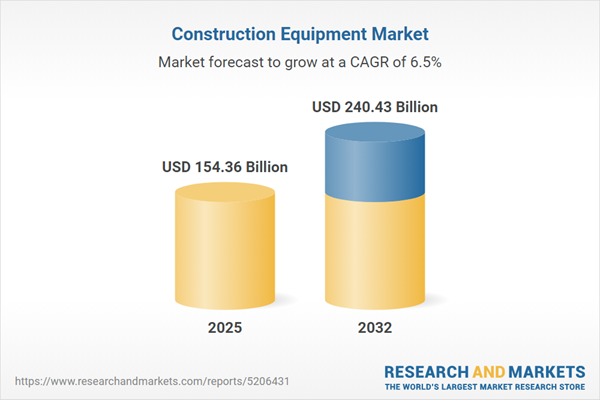Speak directly to the analyst to clarify any post sales queries you may have.
The construction equipment market is experiencing notable transformation, shaped by economic shifts, regulatory changes, and technological advances. Senior leaders require a strategic understanding of this environment to effectively navigate risk, evaluate growth pathways, and drive competitive outcomes.
Market Snapshot: Construction Equipment Market Growth Outlook
The construction equipment market surged from USD 145.57 billion in 2024 to USD 154.36 billion in 2025. Projected to grow at a CAGR of 6.47%, the market is on track to reach USD 240.43 billion by 2032. This momentum stems from robust government infrastructure investments, continuous urbanization, and the need for advanced machinery to address evolving project demands. Heightened regulatory pressures and ongoing labor cost increases further fuel market innovation, prompting stakeholders to modernize fleets and implement digitized operational models.
Scope & Segmentation
This comprehensive report delivers in-depth coverage and strategic assessment across the following segments and regions:
- Product Type: Concrete and road construction equipment, earth moving equipment, heavy construction vehicles, lifting equipment, material handling equipment
- Power Output Range: Units spanning less than 100 HP, 100–500 HP, and above 500 HP address diverse contractor and project needs
- Fuel Type: Diesel, electric, and gasoline-powered options reflecting transition to lower-emission solutions and regulatory compliance
- Design Type: Crawler and wheeled models tailored for terrain adaptability and efficient project deployment
- Autonomy: Manual and autonomous construction equipment, with autonomy gaining traction in modern job sites
- Sales Channel: Aftermarket providers and original equipment manufacturers (OEMs) deliver solutions tailored to capital purchases and ongoing service needs
- End User: Construction companies, government and public infrastructure authorities, mining firms, oil and gas operators, and rental service providers
- Regional Coverage: Americas (including North America and Latin America), Europe, Middle East, Africa, and Asia-Pacific
- Manufacturer and Innovation Profiles: In-depth review of key manufacturers such as AB Volvo, Caterpillar Inc., Komatsu Ltd., and others drives competitive benchmarking and partnership evaluation
Key Takeaways for Senior Decision-Makers
- The convergence of rising labor costs, shifting regulatory standards, and customer focus on sustainable practices is accelerating the industry’s move toward automation, electrification, and digital maintenance solutions.
- Manufacturers and rental operators are restructuring portfolios with connected, modular equipment while introducing flexible subscription models to align with evolving project requirements.
- Adoption of advanced telematics and remote diagnostics is improving fleet efficiency, asset management, and lifecycle value, changing the traditional ownership paradigm.
- Strategic regional expansions and joint ventures between OEMs, technology firms, and service providers are key for capturing local and global market share in complex regulatory environments.
- Circular economy trends, including remanufacturing and recycling of components, are influencing procurement and design decisions across the industry.
Tariff Impact and Supply Chain Realignment
Recently imposed tariffs on imported construction machinery have triggered adjustments in procurement strategies across North America and beyond. Manufacturers are increasing nearshoring efforts and building local assembly operations to optimize costs and shorten lead times. In response, equipment users are modifying asset deployment strategies, including fleet modularity and shared utilization, to offset budget impact. These ongoing adjustments are also facilitating the emergence of alternative supply chains and new bilateral trade partnerships.
Methodology & Data Sources
This primary research integrates interviews with C-level executives and operations leaders from OEMs, rental firms, and regulatory agencies to capture real-world perspectives. Secondary analysis aggregates findings from industry journals, trade associations, company disclosures, and government reports. Robust triangulation and iterative validation ensure accuracy and actionable insights for strategic planning.
Why This Report Matters
- Equips senior management with targeted intelligence to inform investment, procurement, and go-to-market strategies in a volatile construction equipment landscape.
- Delivers segment-by-segment perspectives to facilitate priority setting across product innovations, regional expansion, and talent retention.
- Supports effective risk management through analysis of supply chain disruptions, regulatory shifts, and technology adoption paths.
Conclusion
B2B stakeholders in construction equipment can leverage this analysis for clear vision on opportunity pathways and emerging risks. Informed strategies will drive resilience, adaptability, and long-term growth across global markets.
Additional Product Information:
- Purchase of this report includes 1 year online access with quarterly updates.
- This report can be updated on request. Please contact our Customer Experience team using the Ask a Question widget on our website.
Table of Contents
3. Executive Summary
4. Market Overview
7. Cumulative Impact of Artificial Intelligence 2025
Companies Mentioned
The companies profiled in this Construction Equipment market report include:- AB Volvo
- Caterpillar Inc.
- Atlas Copco AB
- CNH Industrial N.V.
- Deere & Company
- Doosan Group
- Fayat Group
- Guangxi LiuGong Machinery Co., Ltd.
- Hangcha Group Co., Ltd.
- Haulotte Group by Solem SA
- HD Hyundai Construction Equipment Co.,Ltd.
- Hitachi Construction Machinery Co., Ltd.
- Hysoon Australia Pty Ltd
- J.C. Bamford Excavators Limited
- Kobe Steel, Ltd.
- Komatsu Ltd.
- Kubota Corporation
- Larsen & Toubro Limited
- Liebherr-International Deutschland GmbH
- Sany Heavy Industry Co., Ltd.
- Shantui Construction Machinery Co., Ltd.
- Sumitomo Heavy Industries, Ltd.
- Tadano Ltd.
- Takeuchi Mfg. Co., Ltd.
- Terex Corporation
- Toyota Industrial Equipment Manufacturing, Inc. by Toyota Industries
- Wacker Neuson SE
- Xuzhou Construction Machinery Group Co., Ltd.
Table Information
| Report Attribute | Details |
|---|---|
| No. of Pages | 184 |
| Published | November 2025 |
| Forecast Period | 2025 - 2032 |
| Estimated Market Value ( USD | $ 154.36 Billion |
| Forecasted Market Value ( USD | $ 240.43 Billion |
| Compound Annual Growth Rate | 6.4% |
| Regions Covered | Global |
| No. of Companies Mentioned | 29 |









